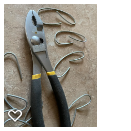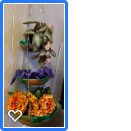Hi again., Time for another project made from recycled goodies. I am a member of a group called the gourd patch and we get together about once a month and make things out of gourds. I have been saving up some scraps and now it is time to put them to use. We are going to make a hanging plant holder out of some of these extra gourd pieces. You would be surprised at how versatile the humble gourd is. Remember the native Americans used them for many purposes. They are naturally waterproof and strong. Let's see what we can make.
Supplies and Equipment.Gourd pieces (preferably the bottoms of 3 escalating sizes of gourds)
Proxxon mini jigsaw
Proxxon proffessional rotary tool
Proxxon cordless mini belt sander
spray paint or other decorating medium
about 10 feet of light chain or rope
pliers,
heavy gauge wire.
(I used some pennies 18cents worth) as an accent and to strengthen my gourds)
Ok, let's get started. First, I want to show you a raw gourd, which is a good place to start if you haven't collected scraps. Warning, they come dirty and need a bit of elbow grease to spruce them up. Nothing that a pot scrubber can't fix.


After cleaning it up, I drew a pencil line around the gourd where I intend to make my cut. Then I used my
Proxxon professional rotary tool and a 1/4" brad point bit to make a small hole just above my line. This is where I will insert my saw blade to cut the gourd.
I simply followed my line and cut the bottom of the gourd off

After scraping away the mess inside I decided to scallop the edges which I did using the Proxxon mini jigsaw again. Then I picked up my Proxxon cordless mini belt sander and smoothed everything.

I used spray paint to decorate my 3 "bowls"
When everything was dry I used my
Proxxon rotary tool to drill 3 holes equal distance apart in each gourd bowl approx 1 inch down from the top.
I got to thinking that with the weight of the flower pots maybe the wire might pull through the gourd so I took an extra step and made my own washers out of pennies that I drilled the same size hole in using again the
Proxxon professional rotary tool. These I glued to the inside and outside of the gourd where the wires will go through.
I bent my wire to make hooks where i will fasten the gourds to my chains.
Lastly, I cut my chains into 3 equal pieces and attached the gourds to them using the hooks. Look you can hang your bathroom supplies or other things if you want. But I am going to use it for some small potted plants.
That's it. This project has a lot of potential. I took a shortcut with the spray paint.
You can do better. It's a fun project. Give it a try.
Thanks for visiting. Check out the
Proxxon site. These smaller tools are fun and easy to use.
Till next time, Play safe. Carol



















































